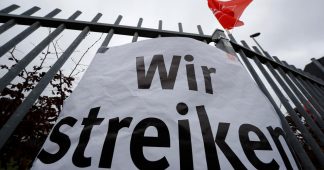Moody’s downgrades Ford’s credit forecast as investors demand deep cuts
By Tom Hall
10 February 2018
The credit rating agency Moody’s downgraded Ford’s rating forecast last week, in a clear warning by Wall Street to the auto giant to prepare for an expected industry downturn and growing militancy among autoworkers.
The move increases the odds that Moody’s will downgrade the company’s credit rating at some point in the near future, making it more expensive for the auto company to borrow money.
“During the past 18 months the company has allowed an erosion in many of the operating disciplines that it established following the 2009 restructuring of the North American auto sector,” Moody’s wrote in a statement explaining the move.
Referring to the company’s planned restructuring of its operations, “Ford’s ability to stabilize its outlook will be determined by the pace at which it can successfully implement the Fitness Redesign undertaking. Notwithstanding the possible benefits of the program, we expect that Ford’s operating performance will remain under pressure into 2019,” it continued.
The reference to Ford’s “operational disciplines” is an allusion to the restructuring of the American auto industry in 2009 under the direction of the Obama administration, a centerpiece of which was the slashing of labor costs through wage and benefits cuts and the increased use of part-time and casual labor. The automakers also moved away from passenger cars in favor of more profitable vehicles such as sports utility vehicles and pickup trucks.
In carrying through this agenda, Ford and the other Detroit-based automakers have relied on the services of the United Auto Workers, which has imposed a series of regressive contracts, undermining wages and working conditions and allowing the expansion of lower paid temporary and part-time workers.
The net result has been years of record profits, in spite of slumping demand and foreign competition, by maximizing the profits made per vehicle through the ruthless exploitation of their workforce.
Nevertheless, the Big Three are under pressure from Wall Street to further “tighten their belts” as indications mount that the boom in the auto industry is coming to an end.
Ford’s annual earnings report last month was below analysts’ expectations and was seen by investors as the most underwhelming among the Detroit auto companies, despite the fact that it increased its profits by 65 percent to $7.6 billion in 2017. Ford CEO Jim Hackett, who was installed last year in a boardroom coup by Wall Street, admitted in a conference call with investors last month that the company was not yet as financially “fit” as its competitors. Ford has warned that its earnings per share would probably decline in 2018.
Meanwhile, Fiat Chrysler (FCA), the smallest of the three companies, reported that it had nearly doubled its profit from 2016 to $4.35 billion. While General Motors reported a loss of nearly $4 billion, investors were generally optimistic because of strong results in North America and China, and because the losses were primarily from ventures, such as the European Opel-Vauxhall subsidiary, which the company had shed over the course of the year.
Investors are also upset that Ford is currently sitting on a $28 billion cash hoard. However, instead of calling for the company to invest this money in new production or technologies, Wall Street has demanded that Ford dip into this reserve to inflate the company’s share prices through stock buybacks.
While few details have been released about Ford’s plans for its “Fitness Redesign” initiative, much to the consternation of wealthy investors, it is clear that it will involve massive cost-cutting and layoffs. In a statement released in October, Ford announced plans to slash operational cost growth by 50 percent and cut spending on materials and engineering by $14 billion by 2022, while re-focusing even more on higher-profit trucks and SUVs and sharply reducing the number of orderable combinations of its vehicles. Hackett, who had little to no experience in the auto industry before becoming CEO, had already built a reputation as a ruthless cost-cutter. As the head of the Steelcase furniture company, he closed half of its US facilities and laid off thousands of employees.
While it was not explicitly raised in the Moody’s report, there can be no doubt that the downgrading of Ford’s credit forecast reflects deep anxiety that Ford’s cost-cutting measures will meet with explosive opposition from autoworkers, which the UAW and its counterparts throughout the world may be unable to control. Ford’s plant in Craiova, Romania was the site of a wildcat strike in December against wage cuts agreed upon between the company and Ford Craiova Automobile Union. In the United States, the ongoing corruption scandal in the UAW has severely undermined the already badly damaged credibility of the union, which for decades has served as the chief mechanism for the enforcement of management’s dictates in the auto factories.
That the ruling class as a whole is gripped with the fear of a counter-offensive by the working class against decades of givebacks and layoffs is demonstrated by the fact that the ongoing sell-off on the stock market was initially triggered by a somewhat better-than-expected report on US wage growth.
The Moody’s report is effectively a declaration by Wall Street that they are putting Ford on notice: if you do not succeed in further slashing production costs and squeezing more money out of your workforce, you will be punished by making it more expensive for you to borrow money.











